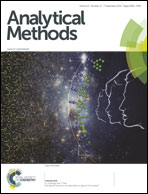Derivatization and analysis of levoglucosan and PAHs in ambient air particulate matter by moderate temperature thermal desorption coupled with GC/MS†
Abstract
A thermal desorption method followed by GC/MS analysis has been developed for efficient analysis of levoglucosan and PAHs in particulate matter. The method requires sample derivatization using N,O-bis(trimethylsilyl)trifluoroacetamide with 1% of trimethylchlorosilane. The reaction is carried out directly in the liner of a commercial thermo-desorption system on 2.1 mm PM2.5 filter cuts under optimized conditions of temperature, 20 °C, and reaction time, 5 minutes. A low temperature of 150 °C is used for desorption, minimizing possible artefact formation and allowing simultaneous detection of PAHs. The method is evaluated on a standard reference material NIST 1649a and applied on ambient air samples. For a sampled air volume of circa 200 L, the overall analytical expanded uncertainty (OEU) for levoglucosan at a concentration of 500 ng m−3 is 25%, while its detection limit (LOD) is circa 50 ng m−3. In the case of benzo[a]pyrene, OEU at 1 ng m−3 is 20% and its LOD 95 pg m−3.


 Please wait while we load your content...
Please wait while we load your content...